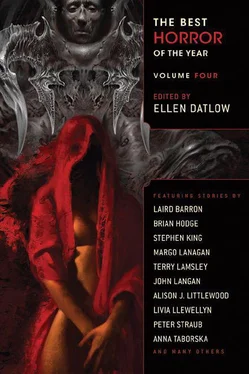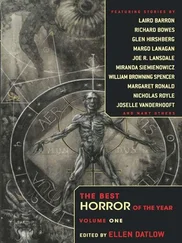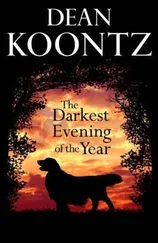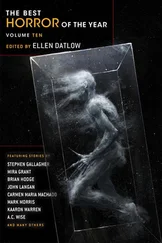The glimpse of fear gives him hope for Kevin, but Kevin’s smile does him in. Maybe the kid sees more than the sex and drugs and blood, but that’s all he wants to see. Kevin has seen Kaleidoscope , and wishes the movie was otherwise. That, Jackson cannot abide.
“Listen, I gotta get going.” Jackson stands. “I got work to do.”
“Oh, okay. Sure.” Kevin’s expression falls. Another flicker of unease skitters across his face.
Guilt needles Jackson — he can’t leave the kid alone like this — but Kevin pastes it over with another goofy, sloppy grin. “Maybe we can catch a midnight screening together sometime?”
Jackson’s pity dissolves; he shrugs into his worn, black trench coat, “Yeah, sure. Sometime.”
Jackson squeezes out of the booth. Kevin turns back to his cold hamburger. Jackson wonders how the kid stays so skinny. As he pushes through the restaurant door, out into the near-blinding sun, Jackson tries to remember to hate Kevin for the right reasons, not just because he’s young and thin.
Jackson steps off the curb, and freezes. Across the street, on the other side of the world and close enough to touch, Carrie Linden walks through a slant of sunlight. She glances behind her, peering over the top of bug-large sunglasses, which almost swallow her face. She hunches into her collar, pulls open the pharmacy door, and darts inside.
A car horn blares. Jackson leaps back, the spell broken. His heart pounds. No one has seen any of the actors from Kaleidoscope since the movie was filmed. There are no interviews, no ‘Where Are They Now?’ specials on late night TV. It plays into the mystique, as though Kaleidoscope might truly be a mass hallucination thrown up on the silver screen. No one real has ever been associated with the film. The credits list the director as B. Z. Bubb and the writer as Lou Cypher.
It’s been nearly forty years since Kaleidoscope was filmed, five years before Jackson was born (but long before he was really born). But Jackson knows it’s her; he would know Carrie Linden anywhere.
Jackson has been in love with Carrie Linden his whole life. (Yes, he considers the first time he saw Kaleidoscope as the moment he was born.)
When Carrie Linden first appeared on the screen, Jackson forgot how to breathe. The scene is burned into his retinas; it, more than anything else, is his private, skull-thrown midnight show. He sees it on thin, blood-lined lids every time he closes his eyes.
Jackson refrains from telling anyone this unless he knows they’ll really understand (and fellow Kaleidophiles always do). The problem — the reason he can’t say anything to converts and virgins — is that the first part of Carrie Linden to appear on screen is her ass.
It’s during the party scene. She walks across the camera from left to right. Long hair hangs down her back, dirty blonde, wavy, split ends brushing the curve of her buttocks. She wears ropes of glittering beads, but the viewer doesn’t know that yet. They are the same beads used to whip Elizabeth in the very next scene, horribly disfiguring her face, but the viewer doesn’t know that yet, either.
What the viewer knows is this: Carrie Linden walks across the screen from left to right. She climbs onto the lap of a man at least twice her age. She fucks him as he lifts tiny scoops of cocaine up to her nose, balancing them delicately on the end of an over-long fingernail.
The first time the viewer sees Carrie’s face, she is sprawled naked on the couch. The camera pans up from her toes, pausing at her chest. Her breathing is erratic, shallow, then deep, then panicked — fast — a jackrabbit lives under her skin. Her head lolls to one side, her eyes are blissfully (or nightmare-chokedly) closed. A trickle of blood runs from her nose.
While Carrie sleeps, but hopefully doesn’t dream, Elizabeth is whipped with Carrie’s beads. Elizabeth screams. She’s on her knees, and sometimes it looks as though she’s stretching her hands out toward Carrie. Some viewers (Kaleidophiles, all) have made the comparison to various religious paintings. Elizabeth’s face is a sheet of blood. When she collapses, her torturer steps over her, and drops the bloody beads around Carrie’s neck. Almost as an afterthought he sticks his hand between Carrie’s legs before wandering away. She doesn’t react at all.
Jackson stares at the pharmacy door for so long that the woman he knows is Carrie Linden has time to conclude her business and slip out again, still darting glances over her shoulder as she hurries away. Once she’s disappeared around the corner, Jackson dashes across the street, ignoring traffic. He yanks open the pharmacy door, and runs panting to the back counter. Luckily, Justin is working. Justin is a Kaleidoscope fan, too. (Aren’t we all?)
“Hey, buddy. Here to get your prescription filled?” Justin winks.
Jackson ignores him, trying to catch his breath. “The woman who just left, did you see her?”
“Yeah. Dark hair and glasses? Not bad for an older broad.” Justin’s grin reminds Jackson of Kevin. He wants to reach across the counter and throttle Justin, who is skinny too, but old enough to know better. He’s older than Jackson (not counting Kaleidoscope years, of course).
“Percocet,” Justin says as an afterthought. He has no compunctions about confidentiality. If he didn’t know the owner too well, he’d have been fired a long time ago.
“Can you get me her address?” Jackson asks. His mind whirls (like colors dissolving behind a credit roll while a woman screams).
“Sure.” Justin shrugs. No questions asked — that’s what Jackson likes about him. Justin consults his computer and chicken scrawls an address on the back of an old receipt.
“Thanks, man. I owe you!” Jackson snatches the paper, spins, and sprints for the door.
“Hey, who is she?” Justin calls after him.
“Carrie Linden!” Jackson slams through the door, answering only because he knows Justin won’t believe him.
The name written over the address Justin gave him is Karen Finch. The address isn’t five blocks from the pharmacy. Jackson runs the whole way, heaving his bulk, dripping sweat, legs burning, breath wheezing. It’s worth a heart attack, worth the return of his childhood asthma, worth anything.
The street he arrives on is tree-lined and shadow-dappled. Cars border both sides of the road, dogs bark in backyards, and two houses over a group of children run in shrieking circles on an emerald lawn.
Jackson approaches number forty-seven. He’s shaking. His mouth is dry in a way that has nothing to do with his mad, panting run. His heart pounds, louder than the dying echoes of his fist knocking against Carrie Linden’s door. What is he doing? He should leave. But Kaleidoscope isn’t that kind of movie. It isn’t a movie at all. It’s an infection, deep in Jackson’s blood.
The door opens; Jackson stares.
Light frames the woman in a soft-focus glow, falling through a window at the far end of the hall. Her hair is dyed dark, but showing threads of gray (or maybe they’re dirty blonde). The ends are split and frayed. She isn’t wearing sunglasses, but shadows circle her eyes, seeming just as large. She is thin — not in a pretty way; her cheekbones knife against her skin. But she is Carrie Linden, and Jackson forgets how to breathe.
The second most famous scene in Kaleidoscope is the carnival scene. It’s the one most viewers (not Kaleidophiles, mind you) rewind to watch over and over again. It’s spawned numerous chat groups, websites, message boards, and one doctoral thesis, which languishes untouched in a drawer.
The scene goes like this: the characters go to a carnival — Carrie, Lance, Mary, and Josh, even Elizabeth, even though her face is horribly scarred (but not Lucy, because she’s dead). The carnival is abandoned, but all the lights are on and all the rides are running. The night flickers with halogen-sick lights, illuminating painted rides and gaudy-bright games. The whole scene drifts, strange and unreal.
Читать дальше












